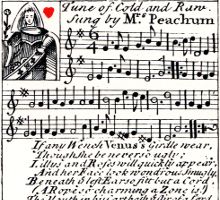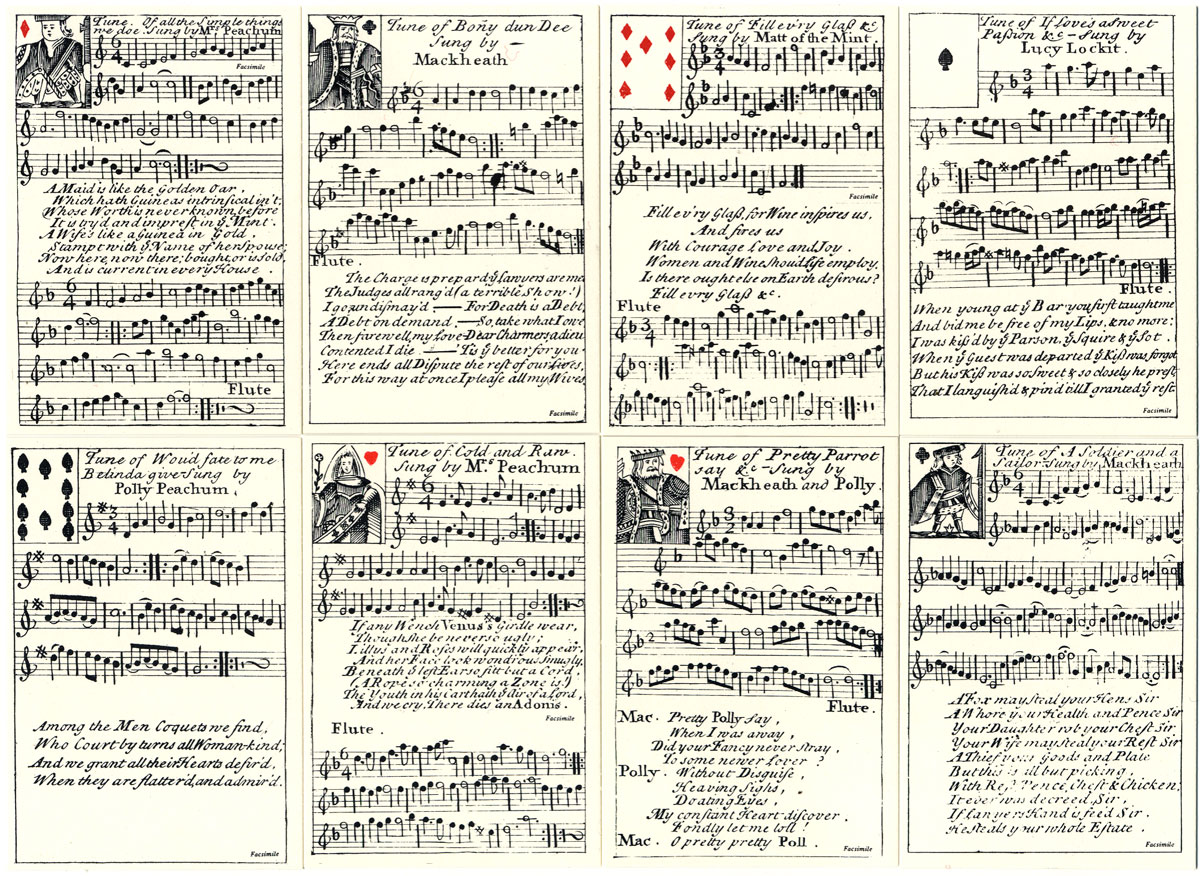The Beggars’ Opera
The Beggars’ Opera Playing Cards were first published in 1728. The cards carry the words and music of the songs from Gay’s opera, which was intended as a parody of current Italian works. The music was taken from many popular tunes of the day.

The Beggars’ Opera Playing Cards, 1728
The Beggars’ Opera Playing Cards were first published in 1728. The cards carry the lyrics and music of the songs from John Gay’s opera, which was intended as a parody of current Italian works. The music was taken from many popular tunes of the day, mostly English and Scottish, even some French, and chosen and arranged by John Christopher Pepusch, a German who had settled in England and who was a composer as well as an adapter of stage musical works. The cards were engraved and printed from copper plates, with the red suit symbols being applied later by stencil. The court cards contain interesting miniature versions of the standard full-length figures used on playing cards at the time.

Above: the Beggars’ Opera pack of playing cards was first published in 1728, the year of the first production of the opera, by John Bowles, a member of the famous London family of mapmakers and printsellers. "The Beggar’s Opera" is so called because it opens with a dialogue between a ragged beggar, who claims to be the author, and one of the actors. The beggar does not return until the final scene, but meantime the stage is taken over by the more familiar, even notorious characters, whose names are still household words. A facsimile of the pack is part of a range published by Harry Margary. Cards from the facsimile edition courtesy Giles de Margary. Packs can be ordered directly from www.harrymargary.com
Nine of Clubs: A Nine of Clubs was preserved at Strawberry Hill as a curious musical memento. The poet Gay had inscribed upon it a couplet from the Beggar’s Opera and given it, signed, to a lady as a souvenir.

By Simon Wintle
Member since February 01, 1996
I am the founder of The World of Playing Cards (est. 1996), a website dedicated to the history, artistry and cultural significance of playing cards and tarot. Over the years I have researched various areas of the subject, acquired and traded collections and contributed as a committee member of the IPCS and graphics editor of The Playing-Card journal. Having lived in Chile, England, Wales, and now Spain, these experiences have shaped my work and passion for playing cards. Amongst my achievements is producing a limited-edition replica of a 17th-century English pack using woodblocks and stencils—a labour of love. Today, the World of Playing Cards is a global collaborative project, with my son Adam serving as the technical driving force behind its development. His innovative efforts have helped shape the site into the thriving hub it is today. You are warmly invited to become a contributor and share your enthusiasm.
Related Articles

Catch the Kaiser
Card game with non-standard suits, featuring British military leaders from WWI plus the Kaiser.

Happy Families
A cautionary tale...

Quaterne
A Victorian quartet-style children’s card game by Goodall & Son.

The Molassine Company and its link to Whist and Bridge
A savvy marketing strategy blending Victorian decorative design with Edwardian practicality.

Waddington’s faux books
Waddington’s faux book set containing four packs of playing cards and bridge markers.

Double Dummy Bridge
In the early 20th century several firms began to promote whist or bridge as a game for two.

Ogdens Beauties & Military cigarette cards
Cigarette cards featuring beauties and military uniforms with playing-card insets.

Boddingtons Bitter playing cards
Cool-looking courts advertising Boddingtons Bitter, originally brewed in Manchester.

OXO Faces of the Millennium Dinner
Twentieth-century personalities promoting a millennium dinner at the Oxo Tower in London.

Pathé Marconi
Special promotion pack for French record company Pathé Marconi.

Kids Fun Box playing cards
Colourful cards for children with four non-standard suits connected with the natural world.

Tangle Foot Ale
Badger Brewery Tangle Foot strong ale advertising pack.

Scientific Whist
“Scientific Whist” : standard cards with instructions for play on the faces by Chas Goodall & Son, 1...

Agent Provocateur
Branded lingerie collection in a pack of pin-up playing cards.

Nimbus playing cards
Mike Steer’s weather-themed pack with suits in four colours and backs for cardistry.

Agatha Christie and Playing Cards revisited
Agatha Christie uses card-play as a primary focus of a story, and as a way of creating plots and mot...
Most Popular
Our top articles from the past 28 days

